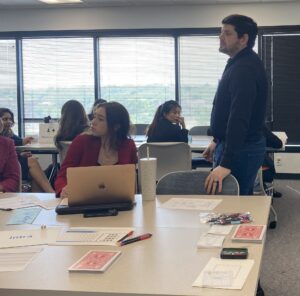AN EXCITING LEAN SIMULATION WITH 20 UNIVERSITY STUDENTS
THE FACILITATORS
On Tuesday, April 16, 2024, Stephen and his wife, Kayti, were joined the by talented Jonathan Lewis to facilitate an interactive simulation designed to empower future health care leaders to make positive change. They traveled to the University of North Texas Health Sciences Center in Fort Worth, Texas to discuss Lean applications within health care to the Performance Improvement class. The class is taught by the engaging Professor, Robert Simmons, who spent several years in the hospital setting improving health care processes, to include being among the first hospitals in the United States to design processes that delivered large numbers of Pfizer vaccinations to clinicians, a process involving a close coordination between pharmacy preparation and vaccine delivery.

THE LEAN SIMULATION – CURRENT STATE
After a brief introduction, Stephen, Kayti and Jonathan plunged the class into organized chaos, blending videos, instruction, activities and more to engage the class, most of which is inspired by Stephen’s book, The Progressive Hospital: A Lean Hope. As mentioned before, the class centered on a simulation, teaching the students about Lean Principles and 5S (Sort, Straighten, Shine, Standardize, and Sustain). For three hours, the class explored the opportunities for health care improvement in ways that only Lean could do. Stephen, Kayti, and Jonathan took turns guiding the class during each phase of this experiential learning exercise.
The class began with a simulation representing the current state within the surgical program with the goal to move 15 patients through the process within four and a half minutes. They achieved only half that goal. Not only did they not meet the customer demand for throughput, costs related to the process skyrocketed with defects, patients waiting, and more.

IMPROVING THE CURRENT STATE
After the completion of the first round, Stephen had the participants stand up for everyone in the class to see, putting them in the spotlight. He then asked everyone in the room give their thoughts on what they observed. Meanwhile, the simulation participants fidgeted, shifting their weight from one foot to the other, as everyone in the class nitpicked their efforts. Stephen then turned to the participants and asked them how they felt about everyone critiquing their work, then mental light bulbs turned on throughout the class room.
When Stephen asked the participants to give their perspectives, the class gained greater insight on the root causes of their problems that drove the inefficiencies, empathy for the participants on how they felt working with a bad process, and embraced a willingness to take part in helping, not directing, to improve the process.
Over the next three hours, the class participated in 5S, Learning to See Waste, and problem-solving exercises, all geared to creating a future state for the simulation. They used the Plan Do Check Act method to problem solve the waste, and other challenges. The 5S exercised stimulated a competitive spirit as class members paired up to undergo six rounds where they strived to find and circle fifty numbers sequentially within fifty seconds. Each pair had two separate responsibilities. The first, to circle the numbers. The second maintained quality control, ensuring the numbers are circled completely. The first round demonstrated an ugly current state, followed by improvements made with each of the five S’s in the 5S method.

THE LEAN SIMULATION – IMPROVED STATE
The improved state reduced waste, leveled workload, gave more time for patient experience and quality, sequenced the work, managed the waiting, and made it simpler to address issues. Despite all the improvements made, Stephen had one more task for them…5S their area. The participants sorted out what they didn’t need, such as scrap paper and more. Made sure the tools they needed were accessible. They cleaned their area, and standardized their work stations. Other class members responsible for quality control, then made adjustments to their process, making it easier for the simulation participants to do their jobs. Before the simulation commenced, the workstations underwent one last check.
The team completed moving all fifteen patients in 3:47 seconds (note: According to demand, perfect would have been 3:45 seconds). It is notable that, unlike the first noisy round, this improved state was eerily silent, while doubly more productive and less stressful.
LESSONS LEARNED
This exercise taught the class several things. First, it is important to instill the basic fundamentals that empower individuals and teams to make small, continuous change. Second, they learned to design processes that will meet the demand without overburdening the process, equipment, the patient, or the staff. Most important, they learned that team member experience, customer experience, quality, productivity, and more were not competing priorities that worked in silos, but when appropriately aligned, helps to create processes that make it simple to deliver exceptional results for all stakeholders.

THE LEAN SIMULATION IMPACT
Stephen, Kayti, and Jonathan are excited that their volunteer work to inspire future health care leaders, and are excited to see what they do with their newfound knowledge and experience. In the future, they hope to hear exciting stories by these talented students on how they made a difference to help their community to address their health care needs and live improved lives.
Connect with Stephen and Jonathan on LinkedIn.

Get your signed copy of The Progressive Hospital: A Lean Hope here for as low as $10.
